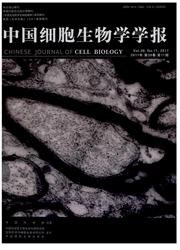

 中文摘要:
中文摘要:
该文探讨了人肝星形细胞(hepatic stellate cells,HSC)对肝癌细胞(Hep G2、SMMC-7721)的迁移、侵袭能力和上皮–间质转化(epithelial-msenchymal transition,EMT)的影响及其机制。采用条件培养法培养肝癌细胞,利用细胞划痕和Transwell实验分析肝星形细胞对肝癌细胞的迁移和侵袭作用。Western blot分析肝星形细胞自身及其分泌到培养液中趋化因子CXCL1[chemokine(C-X-C motif)ligand 1]和肝癌细胞的CXCL1受体2—CXCR2(CXCL1 receptor 2)的表达量,以及条件培养下肝癌细胞中p-PI3K、p-AKT、p-GSK-3β和Snail的表达变化。激光共聚焦显微术和Western blot检测肝癌细胞上皮标志物E-cadherin、间质标志物N-cadherin和Vimentin的表达变化。结果显示,在HSC中大量表达并分泌趋化因子CXCL1,而肝癌细胞Hep G2、SMMC-7721中高表达CXCR2。肝癌细胞通过条件培养后,细胞形态改变,细胞黏附下降,细胞迁移和侵袭能力增强,上皮标志物E-cadherin蛋白表达下调、间质标志物N-cadherin蛋白和Vimentin蛋白表达上调,PI3K/AKT信号通路中的关键成员PI3K和AKT磷酸化水平上调,p-GSK-3β和转录因子Snail表达上调。在肝癌细胞条件培养下加入CXCR2受体的特异性抑制剂(SB265610)后,肝癌细胞上皮标志物E-cadherin蛋白表达上调、间质标志物N-cadherin蛋白和Vimentin蛋白表达下调,p-PI3K、p-AKT、p-GSK-3β和Snail的表达下调。以上结果说明,肝星形细胞可能通过CXCL1/CXCR2轴活化PI3K/AKT信号通路并最终促进肝癌细胞上皮–间质转化。
 英文摘要:
英文摘要:
This research investigated the influence of human hepatic stellate cells(HSC) on the migration, invasion and EMT of hepatocellular carcinoma(HCC) cells and underlying mechanism. HCC cells(Hep G2, SMMC-7721) were co-cultured with conditional medium of HSC or HSC themselves. Cell migration and invasion were detected by methods of cell wound healing and Transwell chamber assays. Product of CXCL1 in HSC and HSC-conditional medium(HSC-CM), the expression of CXCR2(CXCL1 receptor 2) in HCC cells, and p-PI3 K, p-AKT, p-GSK-3β and Snail in conditional cultivated HCC cells were detected by Western blot. The changes of epithelial markers, E-cadherin, mesenchymal markers, N-cadherin and Vimentin in HCC cells were detected by laser scanning confocal microscopy(LSCM) and Western blot. The results showed that HSC produced much chemokines CXCL1, while HCC cells(Hep G2, SMMC-7721) highly expressed CXCL1 receptor CXCR2. Moreover, their morphology changed, adhesion ability decreased, migration and invasion ability enhanced, the expression of epithelial marker E-cadherin was downregulated and mesenchymal markers N-cadherin and Vimentin were up-regulated in conditional cultivated HCC cells. Furthermore, the phosphorylation levels of the important members of PI3K/AKT signal pathway, PI3 K and AKT were up-regulated, as well as levels of p-GSK-3β and transcription factor Snail under conditional cultivation. In contrast, the expression of epithelial marker E-cadherin was up-regulated, but mesenchymal markers N-cadherin and Vimentin were down-regulated, and intracellular p-PI3 K, p-AKT, p-GSK-3β and Snail were down-regulated, when the conditional cultivated HCC cells were treated by CXCR2 inhibitor(SB265610). Our results suggested that hepatic stellate cells promoted epithelial-mesenchymal transition of HCC cells through activating PI3K/AKT signaling pathway by CXCL1/CXCR2 axis.
 同期刊论文项目
同期刊论文项目
 同项目期刊论文
同项目期刊论文
 期刊信息
期刊信息
